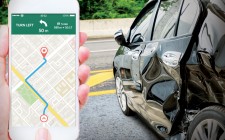
CHICAGO, November 12, 2018 (Newswire.com) - As careful as rideshare drivers can be, accidents are bound to happen and when they do, everything changes. Imagine: The car is totaled, and the driver's neck and head are pulsating in pain. There are a thousand things that are racing through everyone's mind at this point but doing the right thing can save a rideshare driver a ton of issues down the (literal) road.
First, it goes without saying that the health and safety of everyone is of chief importance. As a driver, their physical well-being is their livelihood. As such, LegalRideshare has two goals after a rideshare injury: one, to get the driver back on the road as quickly as possible and, two, to make sure that driver is compensated for damages (medical bills, lost wages and pain and suffering).
If the medical bills and damages exceed the policy limits, the at-fault driver may be personally responsible for the difference.
Bryant Greening, Co-Founder, LegalRideshare
The driver who caused the crash is responsible for paying others’ medical bills and damages. The at-fault driver’s auto insurance will cover the damages up to the policy limits. If the medical bills and damages exceed the policy limits, the at-fault driver may be personally responsible for the difference.
If the rideshare driver is hurt in the accident that they caused, they'll be required to pay for medical treatment out-of-pocket or through their health insurance. Neither their personal nor the rideshare companies’ insurance will compensate them for injuries they caused themselves.
On the other hand, if the other driver caused the crash, it's important to open a claim with his or her auto insurance company. That company will investigate the accident and assess the fault of the drivers. More often than not, however, the insurer will challenge its responsibility to pay for the medical bills and damages. The company will claim the rideshare driver was partially to blame for the crash; they aren’t as injured as they claim, etc.
Because insurance claims are always uphill battles, rideshare drivers must be proactive in protecting their interests, meaning establishing their injury and the cause of it from the get-go. So, without further ado, the rideshare drivers’ checklist for an injury claim:
- Describe the pains to the responding police officers
- Allow ambulance personnel to do examinations
- If warranted, take the ambulance to the emergency room for examination and treatment
- Seek medical treatment within one-to-two days of the accident
- Give a full history of the accident to every medical provider at every appointment. State the date of the incident, exactly how it happened and the mechanism of the injury.
- At every appointment, describe how the injuries limit daily activities
- At every appointment, specifically, describe how the pains feel (throbbing, aching, shooting, radiating, etc.)
- Do not allow for significant gaps in treatment
- Be compliant. Always follow doctor’s orders; don’t skip appointments; take pain medications; do prescribed exercises; see suggested specialists
- Keep copies of bills and receipts for out-of-pocket medical expenses, like co-pays, prescriptions, and medical equipment
By following the above tips, independent sources will create documents to support the injury claim. The evidence will be on the side of the rideshare driver, as police reports, ambulance records, and doctor’s notes are difficult for the insurance company to counter.
Lastly, if injured, drivers should seek legal advice immediately. Injury claims are technical and tricky. The stakes are simply too high to not have the expert care to handle it properly.
Source: LegalRideshare
Share:
